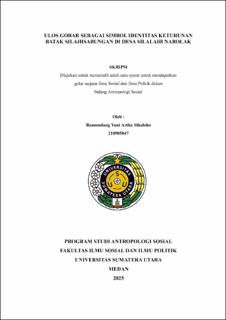Ulos Gobar sebagai Simbol Identitas Keturunan Batak Silahisabungan Di Desa Silalahi Nabolak
Ulos Gobar as A Symbol of Identity of Batak Silahisabungan Descendants in Silalahi Nabolak Village

Date
2025Author
Sihaloho, Rumondang Yuni Artha
Advisor(s)
Tambunan, Rytha
Metadata
Show full item recordAbstract
This research is about ulos, specifically Ulos Gobar, which is known as
one of the ulos of the descendants of King Silahisabungan. Ulos Gobar is a
special ulos that is only worn by male descendants of King Silahisabungan. This
ulos is a symbol for the descendants of King Silahisabungan, because only his
descendants can wear this ulos. This ulos is a symbol of identity with deep
meaning within the cultural and social context of the Batak people descended
from King Silahisabungan. This study aims to understand how the Ulos Gobar
serves as a symbol of identity for the descendants of King Silahisabungan and
how these values are maintained amidst changing times.
This study employs qualitative research methods, collecting data through
in-depth interviews to obtain valid data, observations, and literature reviews to
understand how the Ulos Gobar reflects cultural values and traditions.
The research findings in Silalahi Village indicate that Ulos Gobar not only
serves as a marker of kinship status but also strengthens community solidarity and
acts as a medium for transmitting cultural values across generations. This ulos
possesses a strong symbolic power in reinforcing the identity of the descendants of
King Silahisabungan, both in daily life and during traditional ceremonies.
This study emphasizes the importance of Ulos Gobar as a symbol of
identity that is not only tied to physical aspects but also to cultural values that are
continuously preserved and passed down. In the context of changing times, Ulos
Gobar remains relevant as a community binder and tradition preserver,
demonstrating that despite changes, cultural values can still be maintained.
Collections
- Undergraduate Theses [982]
